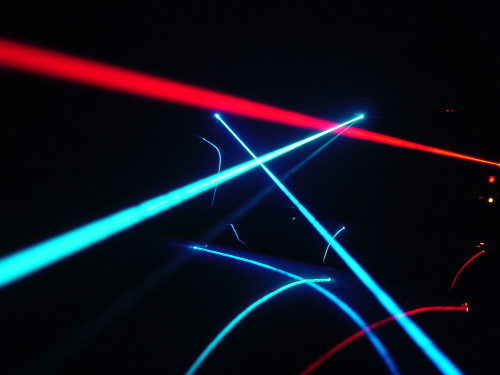
Another brilliant idea: laser beams illuminate fog. (CC BY 2.0/ Jeff Keyzer)
By Philip Ball
I just got back from having my broken wrist X-rayed (it’s doing fine, thanks), and noticed that a laser beam was used to position and align the X-ray source. Hardly the most sophisticated use of these optical devices, it’s true, but a little reminder that there’s probably hardly a day goes by in the life of an average urbanite without the laser’s beam of coherent photons impinging on it. From supermarket barcode scanning to broadband fibre-optic telecommunications, lasers are everywhere.
The fundamental idea behind this mainstay of modern life was published one hundred years ago by Albert Einstein. But blink and you’ll miss it in his seminal paper, “The quantum theory of radiation”, published in German in Physikalische Zeitschrift 18 121 (English translation here). Einstein is trying to work out what Max Planck’s “quantum hypothesis” – that the energy of an oscillator must take discrete values equal to some integer multiple of the oscillation frequency times a constant h – implies for the way light interacts with matter.
Einstein himself had shocked many physicists (including Planck) by proposing in 1905 that we regard Planck’s formula as a physical fact, not just a mathematical trick that avoids the complications of a classical energy continuum. What’s more, Einstein said, this quantization of energy applies not only to the “oscillators” (in essence, the vibrating atoms) that cause “black-body” radiation from a warm object; it applies also to the electromagnetic oscillations of light itself, chopping up a ray into discrete energy packets called photons.
That was the start of the “quantum revolution” that overturned classical physics at the scale of atoms and molecules. We now know that classical laws are not an alternative to quantum laws, kicking in at everyday scales, but are a consequence of them. But in 1917 the implications, and indeed the meaning, of quantization were still unclear. There was no formalism for doing quantum mechanics – Erwin Schrödinger did not write down his iconic equation until seven years later – and so, to address the problem of matter–light interaction, Einstein had to make do with ad hoc methods.
They were clear enough. Planck’s oscillators can emit a photon of the allowed frequency spontaneously and at random with a certain rate, in much the same way as a radioactive atom decays. And the oscillator can also absorb a photon from the ambient radiation field with a different rate. Einstein wrote the simple differential equations for these processes. But he realized that photon emission can also be stimulated by that radiation field. He went on to work out the equilibrium state between these processes of spontaneous absorption and emission, and stimulated emission, and derived Planck’s radiation law.
The implication was that, if one arranges for a large number of atoms to be in identical excited states, a stray photon of the right energy can stimulate one atom to emit another photon, which stimulates another… and all the atoms release their excess energy in a sudden cascade. What’s more, the photon released by stimulated emission will be in phase – coherent – with the one that stimulated it, and so all the light produced in the cascade will be coherent.
In 1955 American physicist Charles Townes of Columbia University in New York, an expert in molecular spectroscopy, and his co-workers showed how stimulated emission could be used to make a device for generating or amplifying microwaves, which they called a maser (microwave amplified stimulated emission of radiation). Three years later Townes and Arthur Schawlow explained how to extend the idea to visible and infrared frequencies to make an “optical maser” – in effect, the laser.
They proposed using ordinary (incoherent) light to pump atoms into an excited state, setting up the “population inversion” in which the atoms are primed to return to their ground state by emitting photons. And their design used an optical cavity – basically two mirrors between which photons would bounce – to trap the emitted photons while they stimulated more emission. The device, they explained, would generate “extremely monochromatic [single-wavelength] and coherent light”. Theodore Maiman of the Hughes Research Laboratories in Malibu, California, described such a device, using a ruby crystal (already used for masers) as the lasing medium, in 1960.
Myth has it that the laser was first dismissed as a “solution looking for a problem”. But its potential was never in much doubt, especially when the first compact semiconductor laser was produced at the General Electric Laboratories in 1962, making the devices more easily integrated with electronics. All the same, they got up to some tricks. In 1969 a laser was bounced off a reflector on the Moon put there by Apollo astronauts. Schawlow even made an edible laser out of gelatin for a joke; more recently they’ve been made from silk, offering the prospect of cheap, flexible biodegradable optoelectronics, and potentially taking lasers to new frontiers.
There’s no evidence that Einstein had any inkling in 1917 of the implications of his work for making a beam of coherent light, let alone the extraordinary array of uses that might have. But that just goes to show once again how practically and unexpectedly fruitful ideas in fundamental science can be.
Guidelines
Show/hide formatting guidelines
this text was deletedwhere people live in harmony with nature and animals</q>
Some text